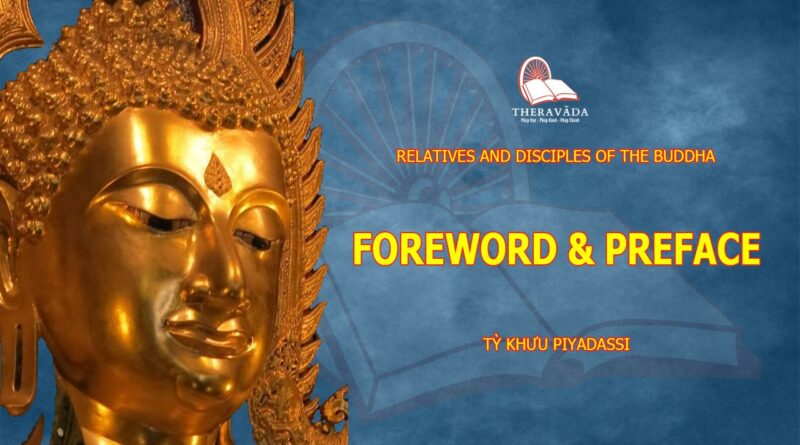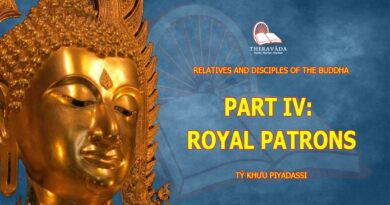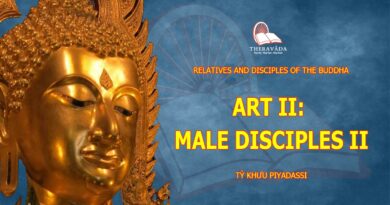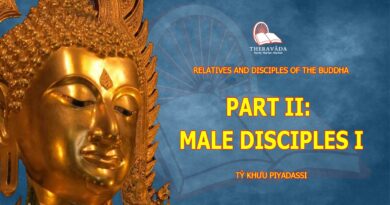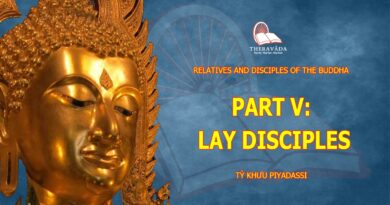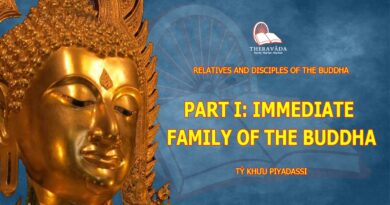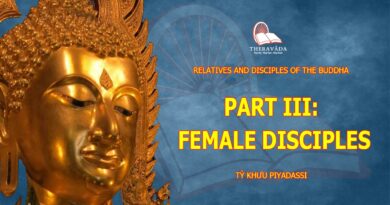RELATIVES AND DISCIPLES OF THE BUDDHA – FOREWORD & PREFACE
Foreword
I admire Mrs. Radhika Abeysekera’s fifth book in her series of Buddhist books. She is an untiring writer who writes on Buddhadhamma with confidence. She tries to fulfil the Noble Path of Right Effort and her efforts have become very fruitful. Her past four books are very popular among readers. Now her readers have a new book to enjoy.
As I see it, the reason for the popularity of her books is her confidence (sradha) in the Buddhadhamma. Many authors write about the Buddhadhamma and how it relates to modern society. Even though the Dhamma (Truth) applies to the past, present and future, if the author does not have a clear understanding of the changing nature of the world – the nature of impermanence, it is not easy to explain the way of the Dhamma to modern society.
The teaching of the Dhamma must be done with understanding and confidence. When we go to a doctor and request treatment for our ailments, we have confidence in the doctor’s treatment. We have to approach the Dhamma in the same way. Only then can we see the real way of the Buddha’s teachings.
When we have confidence in the Dhamma, we see the real nature of the Dhamma. When we explain the Dhamma in writing, we must write with full knowledge and compassion so that others can acquire that same understanding.
In this book, and in Mrs. Abeysekera’s previous writings, she inspires the reader with her confidence in the Dhamma. This particular characteristic of her writing captures the attention of the readers. When you read her stories you can see how she presents the Dhamma in each story. When you read her stories you feel as if you are listening to a virtuous, Buddhist woman explaining the teachings with complete confidence in the Triple Gem – the Buddha, the Dhamma, and the Sangha.
As we do not have many books like this written in English, this work is a generous contribution towards the understanding of the Dhamma for students living outside of Sri Lanka and other Buddhist countries. We need more books like this which will help children to develop the correct knowledge required to live with wholesome values in this modern society.
It is a pity that the modern world does not recognize the importance of these human values that existed in the past: values that brought calmness and contentment to the minds of all people in society. These values are slowly disappearing from use and practice. Many good values such as patience, forbearance, tolerance, generosity, morality, gratitude, loving-kindness, sympathetic joy, altruism and such other noble human qualities are missing from our daily practice. They are not taught to our children in the modern world.
Children are not taught to be tolerant, patient and generous; instead they are taught that it is acceptable to retaliate, to be unforgiving and selfish. We can see in many children’s television programs that producers do not think about the development of good values in the children’s minds. We cannot see evidence of even the slightest attention being paid through programming efforts to children’s moral development. As a result, future generations will develop into societies lacking in good qualities. The world will miss wholesomeness and society will have no real human values.
The degeneration of human values is seen everywhere in society. To avoid this, we should encourage our children and adolescents to read more about religious and historical characters such as are found in this book. How can we expect a peaceful and happy society when we neglect the moral education of our children?
It is very important to understand that good values can be easily forgotten. It is difficult to develop good values in the minds of people who possess dormant unwholesome qualities such as greed, anger and delusion in their inner minds. Our fault today is that we expect happiness and peace by spending money but we have no time to reflect and don’t try to understand how to acquire true happiness or peace. Unhappiness and absence of peace appear but we do not understand how to get rid of them. Without knowing the root cause we try to treat the symptoms of the disease.
The Buddha’s advice for this is to understand, discipline the mind, and eradicate the cause, or the root of the disease. It is good to understand before attempting to uproot the cause. It is not wise to ignore, suppress or run away from the problem. Our children are unfortunate in that they are not given the instruction that will teach them to correct these characteristics in school.
In the old days people had time to teach this to children. Unfortunately, modern children are missing this opportunity. They are not given this instruction at home, in school or at church. Adults expect calm and peaceful behaviour from children without first teaching them to behave and live in peace and harmony.
The average modern American child gets only ten minutes a day to talk with his parents as the parents are busy with their daily work. How can we expect innocent children who know nothing of the realities of this world to do as we want if we do not take the time to teach the values required to accomplish this?
Without first instructing our children or teaching them through example, we describe the concept of human rights and we speak about their rights. We encourage them to search for their rights. What rights can they earn without first learning to respect their parents and elders? It is the duty of the parents who brought the children into this world to teach them good qualities at home. Teaching them how to earn money only does not complete their education. It is also important to teach them the manners and human qualities and values that will allow them to live peacefully and happily as productive members of society. They have no other way of acquiring this knowledge if we do not teach them, for they came to this world without knowing the true nature of the world.
This point must be understood by scientists, psychologists and educators. Those who perform research in education have forgotten this important aspect. This is a missing and often neglected concept in modern society and in the field of education.
We are thankful to Mrs. Radhika Abeysekera, who tries to educate our adults as well as our children by teaching the Dhamma as our ancestors did in Sri Lanka. A strong sense of learning and effort in Sri Lanka enabled people to build, even without modern machinery, great reservoirs, nine-story buildings and magnificent temples, the ruins of which can still be seen today, two thousand or more years later. I would like to draw our educators’ minds to think about this and to suggest an arrangement that would fulfil this missing aspect of our innocent children’s education.
I hope our readers, who have been waiting to read Mrs. Abeysekera’s writings on the Dhamma, will be happy to gain the knowledge of the practical human values that are slowly vanishing from our society. My good wishes and loving-kindness to all. May all beings be well and happy!
Kurunegoda Piyatissa (Nayaka Maha Thera)
New York Buddhist Vihara
August 3, 1999
Preface
Relatives and Disciples of the Buddha, which is the second book in the series of Buddhism books that I have written, is my fifth publication. Once the students have knowledge of the life story of the Buddha, they need to be introduced to His relatives and disciples. Parents or educators should introduce the students to the appropriate life stories as they mature in the Dhamma. They will then have a strong foundation and background, which will enhance their studies in the Dhamma.
This book is also written for the purpose of encouraging young students to emulate the lives of these heroic men and women. It has been written using plain language, structured in short chapters, and illustrated by some of the young children of Canada and Sri Lanka so as to appeal to the younger reader.
The positions held by the Buddha’s close relatives and disciples were not chance happenings. They were positions that each of them had aspired to many aeons ago. They were positions of honour towards which each of them had worked tirelessly over many life cycles. As such, I wanted to include in each of these life histories the true beginning – the point at which the aspiration was made. I have researched and attempted to document the true beginning of many of the Buddha’s close relatives and disciples. It should be noted, however, that the Buddha had eighty great disciples on whom He conferred titles, and many thousands of disciples. As it was not possible to include all of them, a selection was made based on their contribution to the preservation of the Dhamma and on availability of material.
I was inspired and suffused with happiness when I worked on these life histories. These great men and women had worked tirelessly over many lifetimes, so that many years later we could still have access to the Dhamma by practising the teaching that they preserved and by following their example. I was inspired, not only because of the fortitude and effort displayed by the Buddha’s disciples, but also because of their determination to renew their aspiration through countless life cycles. They each had the same goal – to help the Buddha in His mission to enlighten men and gods by showing them the path to eradicate suffering. But because of the nature and disposition of each person, each chose a different role and made different aspirations in keeping with their natures.
Maha Maya aspired to be the mother of the Buddha. Her aspiration, made many aeons ago, was to bring to birth a child who would be The Enlightened One. Yasodhara, His wife, aspired to be His helpmate. Over countless lives she worked tirelessly, supporting His every decision, and actively participated in helping Him complete the ten perfections. Maha Pajapati, on the other hand, aspired to institute and form the order of the nuns (Bhikkhuni). Sariputta aspired to be the Buddha’s first chief disciple and foremost in wisdom. He was the true son of the Dhamma and assisted the Buddha in setting in motion the Wheel of Wisdom. Maha Moggallana chose to be His second chief disciple and foremost in supernatural powers. By using His supernatural powers and his ability to teach he helped many thousands to have confidence in the Dhamma and strive for emancipation. Kassapa aspired to be foremost in austere practices. After the Buddha’s Parinibbana they needed a role model who was pure and austere. It would have been easy to fall into lax practices and materialism. But MahaKassapa was there to help guide and preserve the Dhamma.
Each of the great disciples chose a different attribute in which to excel. Then, using this attribute, they helped the Buddha in the teaching and preservation of the Dhamma for future generations. What wonderful role models for our children! Researching the life stories of these great persons gave me added strength to continue in my mission of teaching the Dhamma and assisting in its preservation for future generations.
The Buddha had many supernatural and psychic powers. In general, however, He did not resort to miracles and psychic phenomena when teaching the Dhamma. This is because the attainment of psychic powers is not the Buddhist goal. The Buddhist goal is Nibbana – the total destruction of suffering. He did not want His followers, enticed by miracles, to seek psychic powers as opposed to the supreme bliss of Nibbana. There were, however, instances when He used his psychic powers to prepare His audience for the Dhamma. At times the pride of the people or their need for the supernatural had to be addressed first. And so we have instances like the Twin Wonder (Twin Miracle) that the Buddha performed to destroy the pride of the Sakyans.
Though the powers of the Buddha far exceeded those of His disciples, many of them also had supernatural and psychic powers. In attaining Arahanthship the great disciples acquired the ability to see into their past births in 100,000 world cycles. Four of His disciples, Sariputta, MahaMoggallana, Yasodhara and Bakkula, could see back into infinite periods of time. Arahanths like Maha Moggallana, Maha Kassapa and Anuruddha had the power to visit the celestial and Brahma realms at will. Anuruddha could also view 1,000 world systems.
In this book I have included instances of such supernatural powers. I have also attempted to cross-reference such instances by comparing the teachings of the Buddha to those of the great disciples. Over time, it is possible for the original words of the Buddha to be changed through translation errors and poetic embellishment of authors. The Buddha, who recognized this possibility, left us a set of instructions to follow before we accepted His teachings as absolute. I have also included in this book the way in which the Arahanths preserved the Dhamma. This will help the reader to form an opinion on the authenticity of the material. The Buddha’s instruction, known as the Mahapadesa, and by which His words should be tested, is as follows:
“A Bhikkhu may say thus – From the mouth of the Buddha Himself have I heard, have I received thus: This is the Doctrine, this is the Discipline, this is the Teaching of the Master. His words should not be accepted or rejected. Without either accepting or rejecting such words, study thoroughly every word and syllable and then put them beside the Discourse (teachings) and compare with the Monastic Disciplinary Rules. If, when so compared, they do not harmonize with the Discourses and do not agree to the Disciplinary Rules, then you may come to the conclusion: Certainly this is not the word of the Exalted One, this has been wrongly grasped by the Bhikkhu. Therefore you should reject it. If, when compared and contrasted, they harmonize with the Discourses and the Disciplinary Rules, you may come to the conclusion: Certainly this is the word of the Exalted One, this has correctly been grasped by the Bhikku. Let this be regarded as the first reference.”
The Buddha then went on to dispense the second, third and fourth reference by substituting the words, “Heard from the mouth of the Buddha”, with,”Heard from the mouth of the Sangha, Heard from the mouth of the Thera, and Heard from the mouth of Theri.”
It should also be pointed out that the reader has the choice of accepting or not accepting these events. In the Jnanasara-samuccaya the Buddha said, “As the wise test gold by burning, cutting, and rubbing (on a piece of touchstone), so are you to accept my words after examining them and not out of regard for me.” As such, we should always examine and question the Teachings and accept that which appeal to our reason. The acceptance or non-acceptance of such phenomena does not in any way affect a person’s ability to attain Nibbana. It does, however, add to a better understanding of the spiritual development of the minds of Arahanths.
In addition to introducing the reader to some of the close relatives and great disciples of the Buddha, this book illustrates the exceedingly long time it takes (about 100,000 world cycles) to fulfil a great aspiration and attain Arahanthship. The majority of these persons received the definite proclamation regarding the certainty of the fulfilment of their aspirations at the time of the Padumuttara Buddha. Yasodhar� and His chief male disciples took even longer to fulfil their aspirations, as the level of perfection required was greater. And even though documentation was not available, the possibility exists that these great disciples were striving for these positions and completing virtues even prior to their encounter with the Padumuttara Buddha. It seems very plausible that a certain level of wisdom and spiritual development would have been required for the Padumuttara Buddha to be able to prophesy the certainty of their achieving their goal.
I hope this book will inspire the reader to understand how fortunate we are that these great disciples had the courage and determination to perfect themselves over aeons of time to assist us in our emancipation. Their goal was not just to attain Arahanthship. It was to attain Arahanthship with great attributes which would assist the Buddha in His aspiration to help humanity for many generations, by showing them the path to the total destruction of suffering. It is hoped that this book will inspire others to make similar aspirations, so that future generations may benefit by our efforts just as we are benefiting by the efforts of these great disciples.
This book was not written for the purpose of introducing the Buddha’s teaching. However, it would have been remiss of me not to use the opportunity to introduce the teachings when documenting the life history of Maha Kaccana. Maha Kaccana was foremost in explaining in detail the profound sayings of the Buddha to help novice monks and lay disciples who were not spiritually mature. To illustrate Maha Kaccana’s contribution to the world, I have included some examples from Maha Kaccana’s teachings. As Kaccana was consulted to explain profound and complex teachings, these are for the advanced student. I have attempted to simplify the teachings but it must be recognized that these are teachings from the Abhidhamma and as such are more suitable for the advanced student than the beginner.
Dr. Dewaraja, who presented a paper at the University of Western Australia on “The Positions of Women in Buddhism”, studied the women of Sri Lanka, Thailand, Burma and Tibet over a period of time before the impact of Western influence and compared them to women in other Asian Countries. She concluded that “Buddhism saved the daughter from indignity, elevated the wife to a position approximating to equality, and retrieved the widow from abject misery.” I have attempted to bring out the enormous service that the Buddha performed to women when He instigated the order of the Nuns and proclaimed that women were as capable as men of attaining spiritual heights. The position of women and the beliefs at that time were such that women were treated with great disrespect. I have attempted to bring to light society’s treatment of women at the time of the Buddha and the gratitude that His female disciples felt towards Him for giving them the opportunity for emancipation.
This book, as the other books I have written, is my contribution towards the preservation of the Dhamma for future generations. May I, through this work, continue to develop wisdom, analytical skills and clarity of vision, so that I can transfer the knowledge I have acquired to others with ease, with a view to Nibbana. I also hope that reading this book will inspire others to make similar aspirations, because what one person has done another person can do.
Whilst I researched many books to obtain the material required for this book, special mention needs to be made of some of the pioneers who translated the Pali text to English. Professor Rhys Davids, whose father was a Christian clergyman, decided to study the Pali language and Buddhism for the purpose of proving the superiority of the Christian faith. Instead, Professor Davids modelled his life on the Buddha’s Noble Path and, together with his wife, Mrs. Davids, left a beautiful legacy of the Pali text in English. As many as possible of the Theragatha, or sayings of the elders, were taken from the book Psalms of the Brethren. Due to difficulties in obtaining the original translation, The Elders Verses I, Theragatha and The Elders Verses II, Therigatha by the Pali Text Society of Oxford, as well as the beautiful work, Great Disciples of the Buddha, of the American-born Bhikku, Bhodi, were used as supplements.
Compilations of the lives of the great disciples of the Buddha by the German-born monk, Ven. Nyanaponika, and the German scholar, Hellmuth Heckle, were also invaluable in my research. My grateful appreciation to these forefathers for their dedication in translating the Pali text into English, for the purpose of preserving the Dhamma. Through this book, these international pioneers have contributed to the Dhamma knowledge of many more generations of international students.
Many people contributed their time and effort to make this book special. Children of Canada and Sri Lanka, many of whom are my students, enhanced this text with their beautiful drawings. The children’s perspective of the stories adds a touching depth which brings to life the great persons who preserved the Dhamma so that it would be available for them to study many years later. Their contribution, which has made this book a living memory of my Dhamma classes, is greatly appreciated.
As in the past Ven. Kurunagoda Piyatissa (Nayaka MahaThera) encouraged me in my efforts by writing the foreword and reviewing the book for accuracy and improvement. His vast knowledge of the Dhamma continues to be an invaluable resource in my work. His strength, patience and selfless devotion to the Buddha Dhamma is greatly appreciated.
My good friend, Adrienne Bouchard Langlois, has worked tirelessly in enriching this text with her careful editing. She has undertaken the editing of this book at a time when great demands were being made on her free time. Despite her other commitments, she has ensured the quality of this book by going over this material again and again. The editing of a book is meticulous work that requires countless hours of concentrated effort. Her contribution to this book cannot be measured. Her friendship is a constant source of strength and her determination, inspiration and high standards are now an integral part of my work. My appreciation of her labour of love is boundless.
My friend, Jay Jawroski, has made this book a work of art with her expertise and graphics design. She has designed the cover to reflect the wisdom and compassion of the many disciples and retained the importance of impermanence in the Buddha Dhamma. She has formatted the entire book to enrich its visual impact and has spent countless hours to make it attractive and appealing to the reader. She has scanned the children’s drawings and enriched them thorough her expertise, to reproduce in vibrant colours. Her beautiful work has enhanced the children’s illustrations and helped to bring to life the stories of the great disciples. Her generosity, compassion and experience of life have helped to strengthen my resolve and commitment in the preservation of the Dhamma for future generations. Words cannot describe my appreciation of her efforts and support.
My books are now available on the Internet so that readers from all parts of the globe will have free access to them. Even with the generous help of sponsors, I was experiencing great difficulties in keeping up with the costs of free distribution. The demand far exceeded my supply of books. My friend, Masoud Moradi-Teleghani, has selflessly shared his technical expertise and developed my web site so that students all over the world now have access to my books. The beautiful title page was Masoud’s representation of my work. With his title “From Turmoil to Peace” he effectively captured what I hoped to give to future generations through the Buddha Dhamma. The countless hours he spent formatting this work in HTML, a language that does not have P�li fonts, is greatly appreciated. His technical and artistic abilities, compassion and quiet strength have been an invaluable resource in my work.
And last but not least I would like to thank my family for their consistent support of my work. The many hours I spend on my work is time away from them. By becoming involved in my work they have shared in my contribution to the preservation of the Dhamma. Together with many others they have encouraged me in my struggle to balance my career, family and writing. With understanding and patience they have provided the environment I need for research, teaching and writing. My grateful appreciation for their encouragement, understanding, and patience.
This book has been dedicated to my family, good friends and relatives who have supported me throughout the years in the preservation of the Buddha Dhamma. May I have the opportunity to assist them throughout samsara in their journey to enlightenment. May all beings find peace and lasting happiness!
Radhika Abeysekera
Winnipeg, Manitoba
Canada
May 13, 2000
Source: Budsas.net

